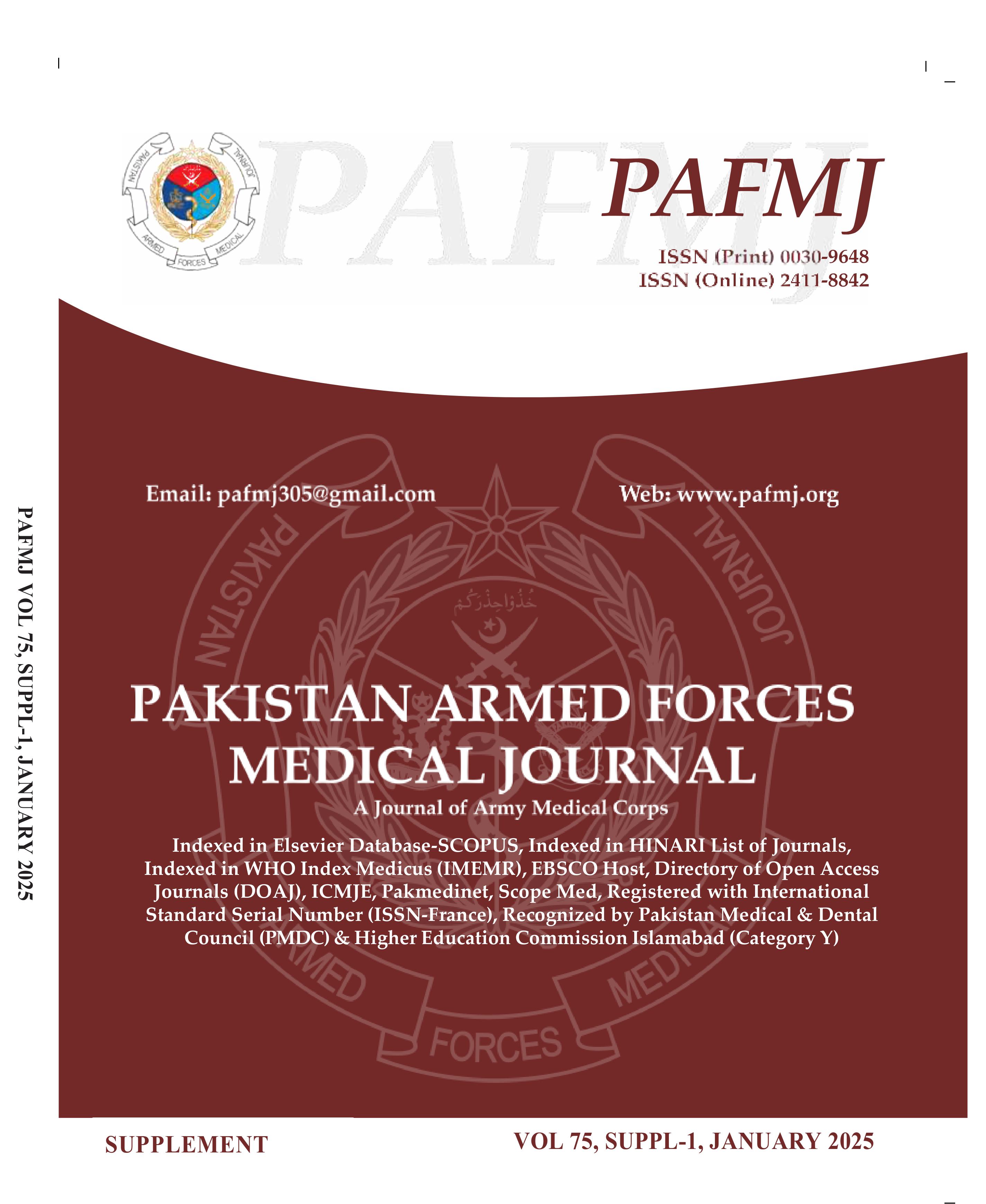Association Between Serum Uric Acid Levels and Severe Pre-Eclampsia
DOI:
https://doi.org/10.51253/pafmj.v75iSUPPL-1.6674Keywords:
Hyperuricemia, Pregnancy, Severe pre-eclampsiaAbstract
Objective: To determine the association of hyperuricemia with severe preeclampsia in pregnancy.
Study Design: Prospective Longitudinal study
Place and Duration of Study: Department of Gynecology, Combined Military Hospital, Multan, Pakistan from Mar 2019 to Jul 2019.
Methodology: A total of 68 women with gestational age 20 weeks, parity 0-5, patients with uricemia level ≥5.5mg/dl has been added in exposed group and patients with uricemia level <5.5mg/dl has been added in non-exposed group. Patients were evaluated by detailed history, clinical examination and BP. All relevant findings were documented on a designed proforma. Severe Preeclampsia was noted from both groups.
Results: Women of 18 to 40 years age were selected with mean age of 29.911± 3.49 years in Group A while 31.558± 3.99 years in Group B. Mean gestational age was 23.264±1.84 weeks in Group A and 24.352±1.99 weeks in Group B. Mean serum uricemia level was 6.961±0.74 mg/dl in Group A and 4.635±0.44 mg/dl in Group B. In group A, severe preeclampsia has been seen in 17(50%) womens as compare to 6(17.6%) womens in group B, (p=0.004, R.R=2.8).
Conclusion: This study concluded that the severe pre-eclampsia was associated with hyperuricemic pregnancy.
Downloads
References
English FA, Kenny LC, McCarthy FP. Risk factors and effective management of preeclampsia. Integr Blood Press Control 2015; 8: 7–12.
Siemons JM, Bogert LJF. The uric acid content of maternal and fetal blood. J Biol Chem 1917; 32: 63–67.
Yalamati P, Bhongir AV, Betha K, Verma R, Dandge S. Relationship of serum uric acid, serum creatinine and serum cystatin C with maternal and fetal outcomes in rural Indian pregnant women. Int J Reprod Contracept Obstet Gynecol 2015; 4(5): 1505–1510.
Jin M, Yang F, Yang I. Uric acid, hyperuricemia and vascular diseases. Front Biosci 2012; 17: 656–669.
Niraula A, Lamsal M, Majhi S, Khan SA, Basnet P. Significance of serum uric acid in pregnancy induced hypertension. Journal of the national medical association 2017; 109(3): 198-202.
Anusha T, Sankaranarayana t. Study of serum calcium, magnesium, uric acid and liver enzymes in pregnancy induced hypertension. Journal of Evolution of Medical and Dental Sciences 2018; 7(11): 1347-53.
Sultana R AS, Sultana N, Karim SM F, Atia F. Association of Serum Uric Acid with Preeclampsia: A Case Control Study. Delta Med Col J 2013; 1: 46–50.
Le TM, Nguyen LH, Phan NL, Le DD, Nguyen HV, Truong VQ, et al. Maternal serum uric acid concentration and pregnancy outcomes in women with pre‐eclampsia/eclampsia. International Journal of Gynecology & Obstetrics 2019; 144(1): 21-26.
Enaruna NO, Idemudia JO, Aikoriogie PI. Serum lipid profile and uric acid levels in preeclampsia in University of Benin Teaching Hospital. Niger Med J 2014; 55: 423–427.
Chen Q LS, Tong M, Wei J, Shen F, Zhao J, Zhao M. Serum uric acid may not be involved in the development of preeclampsia. J Hum Hypertens 2016; 30: 136–140.
Gadde R, Doddaiah DC, Rangappa SS. Relationship between Mean Arterial Pressure, Uric Acid and Calcium with Xanthine Oxidase Activity and Fetal Outcome in Normotensive and Preeclampsia in a Nested Study. Open Journal of Obstetrics and Gynecology 2018; 8(14): 1532.
Hawkins TL, Roberts JM, Mangos GJ, Davis GK, Roberts LM, Brown MA. Plasma uric acid remains a marker of poor outcome in hypertensive pregnancy: a retrospective cohort study. BJOG 2012; 119: 484–492.
Elmas O AY, Simsek T. The relationship between hypertension and plasma allantoin, uric acid, xanthine oxidase activity and nitrite, and their predictive capacity in severe preeclampsia. J Obstet Gynaecol 2016; 36: 34–38.
Masoura S, Makedou K, Theodoridis T, Kourtis A, Zepiridis L, Athanasiadis A. The involvement of uric acid in the pathogenesis of preeclampsia. Curr Hypertens Rev. 2015; 11: 110–115.
Corominas AI, Balconi SM, Palermo M, Maskin B, Damiano AE. Serum uric acid levels and risk of developing preeclampsia. Medicina 2014; 74: 462–471.
Zhao J ZD, Yang JM, Wang M, Zhang XT, Sun L, Yun XG, et al. Maternal serum uric acid concentration is associated with the expression of tumour necrosis factor-alpha and intercellular adhesion molecule-1 in patients with preeclampsia. J Hum Hypertens 2016; 30: 456–462.
Asgharnia M, Mirblouk F, Kazemi S, Pourmarzi D, Keivani MM, Heirati SF, et al. Maternal serum uric acid level and maternal and neonatal complications in preeclamptic women: A cross-sectional study. International Journal of Reproductive BioMedicine 2017; 15(9): 583.
Matias ML, Romao M, Weel IC, Ribeiro VR, Nunes PR, Borges VT, et al. Endogenous and Uric Acid-Induced Activation of NLRP3 Inflammasome in Pregnant Women with Preeclampsia. PloS One 2015; 10: e0129095
Downloads
Published
Issue
Section
License
Copyright (c) 2025 Mirza Sijeel Ahmad, Anam Akram, Mehwish Gillani, Tariq Ahmed Maka, Anas Bin Saif

This work is licensed under a Creative Commons Attribution-NonCommercial 4.0 International License.















